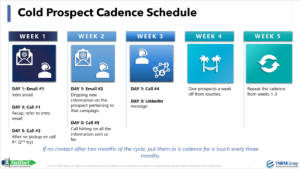Earlier in my career, I was challenged by my sales manager to resuscitate a historically underachieving sales territory. It was a vertical market—healthcare—and it was limited by having very few (approximately one hundred) target customers in the region. I developed a five-step plan that helped me exceed my quota within thirty-six months. In this article, I will detail actionable steps based on my experience that you can replicate to transform your underachieving sales territory into a thriving and lucrative market, creating “quota-busting” results.
- Gain an in-depth understanding of the territory
One of the phrases I like to share with the sales reps I am mentoring is “know thy universe.” In other words, perform the necessary research to be able to answer questions such as:
- How many accounts are in the territory?
- What are the historical sales figures for the territory?
- What are the current performance metrics for the territory?
- What are the market dynamics in the territory?
- What are the customer demographics in the territory?
Being able to answer these key questions will set you up for success, providing you with a clearer picture of what kind of results to aim for and how to move forward.
- Know your top competitors and their strengths/weaknesses
Focusing on your own performance alone is not enough: it is important to know your competitors, their strengths, and their weaknesses. Once you gather this information, tie it back to your sales strategy by identifying the competitive differentiators of your product/service. You may even want to consider working some of the discoveries into your talk track for potential customers. This will provide you with an edge as you share your value proposition.
- Craft specific and strategic messaging
Your competitive differentiators are the unique benefits you provide that other companies can’t. To craft the strongest strategic message for your sales approach, you need to tie those differentiators directly to your prospect’s needs. Also consider which step of the buyer’s journey the customer is in and what information they need to know. This will help you craft value-adding communications that simultaneously build your credibility. According to research by Vonage, 86% of people report that they are more likely to buy a product/service when it is apparent that the sales rep performed research on and understands the goals/needs of the organization they are calling. And yet, 60% of people report that at least 50% of the time, they feel that sales reps have not done enough—or any—research on their organization. This is a good reminder that investing time in research to personalize customer communications pays off.
Furthermore, your messaging should be delivered in 10-12 touchpoints over 90-120 days through the nurture cycle, which is a critical time period during which you are cultivating and developing your relationships with customers. The goal is for you to provide leads with relevant information so that they consider your organization’s products/services when they are ready to make a purchase. The chart below depicts a sample schedule for reaching out to cold leads; it suggests alternating between calls and emails as well as building on information provided in previous touchpoints.
In fact, research by Gartner discusses the importance of sellers providing relevant information to potential buyers throughout the purchase process, claiming that customers who felt like they got helpful information “were 2.8 times more likely to experience a high degree of purchase ease, and three times more likely to buy a bigger deal with less regret.”
Keep in mind that in B2B sales, there are often multiple decision makers, and they may not be the first point of contact you make your pitch to. Therefore, you may need to customize your messaging or call to action accordingly.
- Set clear, achievable goals
Once you conduct market research and gain an in-depth understanding of your territory, it’s time to engage in goal setting. Strike a balance between being optimistic and being realistic, as you want to challenge your team to see improvement, but not discourage them.
If you are unsure of where to begin with goal setting, start by brainstorming a list of possible goals. You can even schedule a meeting with your team dedicated to voicing all kinds of ideas for goals and taking inspiration from each other. Then, narrow down the list to the most relevant and realistic goals and ensure they are specific, measurable, and aligned with your company’s objectives.
- Develop a targeted action plan
With your goals in place, the final step of planning is to consider how to get to your desired end results. Your action plan should cover a timeline, budget, and concrete steps for execution. Flesh out your plan and think through potential challenges as well as how to address them.
Of course, stay mindful of market forces (e.g., the macroeconomic environment) and make adjustments to your plan if necessary.
How FastStart Sales Enablement Program Prepares New Talent to Tackle Challenges
The FastStart Sales Enablement program is a unique six-month sales resource development track that provides focused and intensive training designed to provide entry-level IT sales reps with the skills needed to be successful. The comprehensive curriculum dives into best practices for forecasting, crafting and delivering relevant messaging, following up with customers, and more. Upon graduation from the program, candidates are ready to work independently as full-fledged members of clients’ sales teams. They are set up with the foundations to reach and exceed quota—regardless of how the sales territory performed in the past.
Contact us to learn more about enrolling your new sales reps in our FastStart Sales Enablement program OR creating a custom curriculum to upskill existing employees.







0 Comments